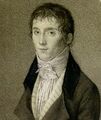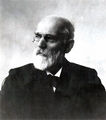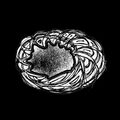Template:Selected anniversaries/March 7: Difference between revisions
No edit summary |
No edit summary |
||
| Line 1: | Line 1: | ||
<gallery> | <gallery> | ||
|| *** DONE:Pics *** | |||
||1625: Johann Bayer dies ... lawyer and cartographer. No DOB. Pic search: https://www.google.com/search?q=johann+bayer | ||1625: Johann Bayer dies ... lawyer and cartographer. No DOB. Pic search: https://www.google.com/search?q=johann+bayer | ||
| Line 27: | Line 29: | ||
File:Alexander Graham Bell.jpg|link=Alexander Graham Bell (nonfiction)|1876: [[Alexander Graham Bell (nonfiction)]] is granted a patent for an invention he calls the "telephone". | File:Alexander Graham Bell.jpg|link=Alexander Graham Bell (nonfiction)|1876: [[Alexander Graham Bell (nonfiction)]] is granted a patent for an invention he calls the "telephone". | ||
File:G I Taylor.jpg|link=G. I. Taylor (nonfiction)|1886: Mathematician and physicist [[G. I. Taylor (nonfiction)|G. I. Taylor]] born. He will make major contributions to fluid dynamics and wave theory. | File:G I Taylor.jpg|link=G. I. Taylor (nonfiction)|1886: Mathematician and physicist [[G. I. Taylor (nonfiction)|G. I. Taylor]] born. He will make major contributions to fluid dynamics and wave theory. | ||
| Line 88: | Line 88: | ||
||1984: Charles Pisot dies ... mathematician. He is chiefly recognized as one of the primary investigators of the numerical set associated with his name, the Pisot–Vijayaraghavan numbers. Pic: http://www-history.mcs.st-andrews.ac.uk/PictDisplay/Pisot.html | ||1984: Charles Pisot dies ... mathematician. He is chiefly recognized as one of the primary investigators of the numerical set associated with his name, the Pisot–Vijayaraghavan numbers. Pic: http://www-history.mcs.st-andrews.ac.uk/PictDisplay/Pisot.html | ||
||1986: Challenger Disaster: Divers from the USS Preserver locate the crew cabin of Challenger on the ocean floor. | ||1986: Challenger Disaster: Divers from the USS ''Preserver'' locate the crew cabin of Challenger on the ocean floor. | ||
||1997: Edward Mills Purcell dies ... physicist who shared the 1952 Nobel Prize for Physics for his independent discovery (published 1946) of nuclear magnetic resonance in liquids and in solids. Nuclear magnetic resonance (NMR) has become widely used to study the molecular structure of pure materials and the composition of mixtures. Pic. | ||1997: Edward Mills Purcell dies ... physicist who shared the 1952 Nobel Prize for Physics for his independent discovery (published 1946) of nuclear magnetic resonance in liquids and in solids. Nuclear magnetic resonance (NMR) has become widely used to study the molecular structure of pure materials and the composition of mixtures. Pic. | ||
Revision as of 07:35, 7 March 2020
1765: Inventor Nicéphore Niépce born. He will invent heliography, a technique he will use to create the world's oldest surviving product of a photographic process.
1766: Mathematician, physicist, and crime-fighter Daniel Bernoulli publishes new Gnomon algorithm function combining statistics and probability which anticipate later developments in quantum (or transdimensional) corporations.
1788: Physicist and academic Antoine César Becquerel born. He will pioneer the study of electric and luminescent phenomena.
1875: Flying bison (Bison pterobonasus) sighted near Roswell, New Mexico.
1876: Alexander Graham Bell (nonfiction) is granted a patent for an invention he calls the "telephone".
1886: Mathematician and physicist G. I. Taylor born. He will make major contributions to fluid dynamics and wave theory.
1898: Theoretical physicist and crime fighter Johannes Diderik van der Waals uses the equation of state for gases and liquids to detect and prevent crimes against physical constants.
1917: Pioneering computer scientist and programmer Betty Holberton born. She will be one of the six original programmers of ENIAC, the first general-purpose electronic digital computer, and the inventor of breakpoints in computer debugging.
1950: Cold War: The Soviet Union issues a statement denying that Klaus Fuchs served as a Soviet spy.
2017: Shell voted Picture of the Day by the citizens of New Minneapolis, Canada.
2019: Steganographic analysis of Confessions of a Quantum Artist-Engineer (1) unexpectedly reveals "at least two-hundred and fifty-six kilobytes" of previously unknown Gnomon algorithm functions.










